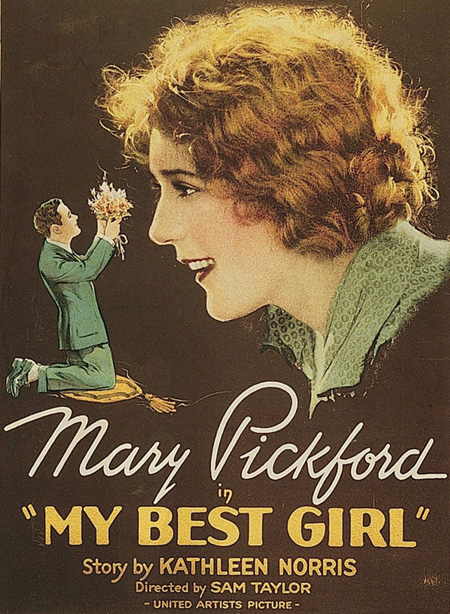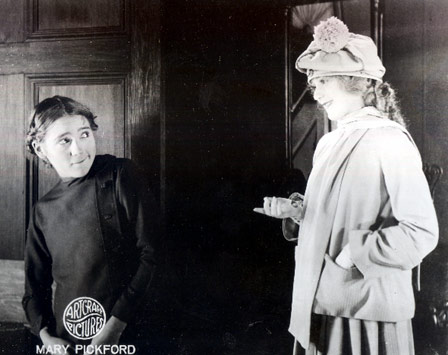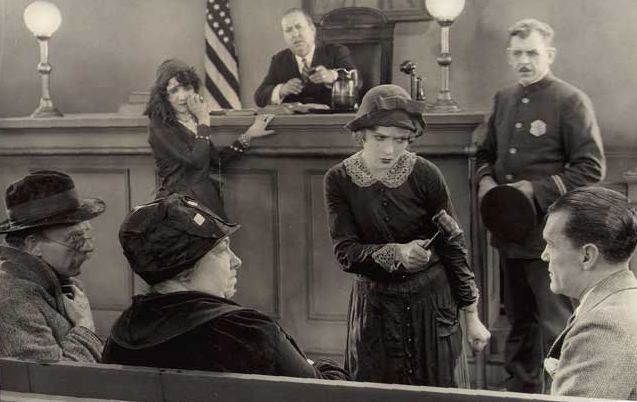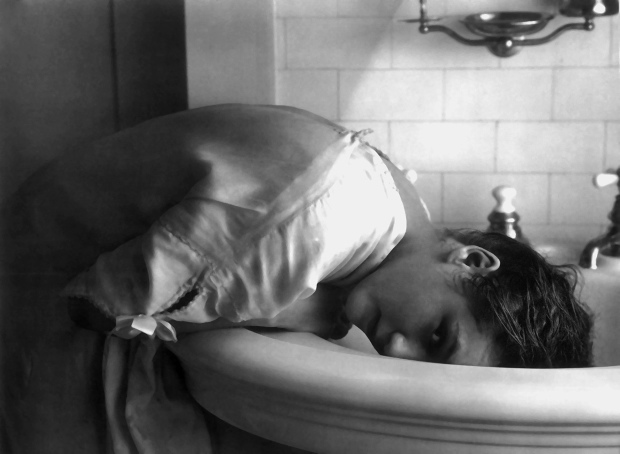
If I hadn't fallen in love with Mary Pickford watching Amarilly Of Clothesline Alley, watching My Best Girl
would have done the trick just as well.
This
is one of the best romantic comedies ever made and perhaps the
sweetest, with the possible exception of Griffith's True Heart Susie.
It's also a transitional film, I think — preserving some of the
bucolic innocence of Susie while pointing the way to the screwball
drawing-room comedies of the Thirties.
The
plot is conventional and silly, about on a level with Pretty Woman in
that regard — a young working-class woman with a job in a department
store gets involved with the wealthy son of the store's owner, who's
working there incognito to get to know the business he will inherit.
The film itself, however, is anything but a trifle. When films this
simple are this great, there's extraordinary art at work — a comment I
would also make about Murnau's Sunrise, which My Best Girl
resembles in some crucial ways. Both are simple love stories about
simple, utterly ordinary people, done without a trace of condescension
and with moments of poetry which are profound.

I'm
beginning to realize that Pickford's range as an actor was awesome.
There's a core star persona that migrates from film to film, bits of
business and attitude that reference the expectations audiences brought
to her films, but the characterizations are unusually diverse for a
star, especially a silent film star. Gish always played Gish in silent
films, though the complexity of Gish was endless — Chaplin always
played Chaplin, though the inventiveness of Chaplin was inexhaustible.
But Amarilly is not My Best Girl's Maggie — you have a sense of meeting someone
wholly different in their respective stories. (And Unity Blake, in Stella Maris, inhabits
a different universe from either of them.)
Mostly
this is the result of Pickford's uncanny ability to suggest an inner
life — to create reactions to conventional situations which are
quirky, distinctive. This has nothing to do with the roles as written,
because the roles are somewhat generic, but with Pickford's absolute
commitment to the moment, to the cinematic present. It's one of the
reasons you can't take your eyes off her.
Buddy
Rogers is a charming looking fellow, a competent actor and a very
skilled light comedian, but he doesn't convey a lot of gravity when
he's onscreen by himself. Yet when Pickford looks at him with an
expression that says, “This guy might amount to something,” you believe
it without question. So many great performances by actors on film are
created in the faces of the actors playing opposite them — Hepburn, for
example, wonderful as she is, reaches a whole new level in her work
with Spencer Tracy . . . he just very quietly gives her her scenes, and
makes us love her in a way we very rarely do when he's not around.
Pickford
does the same for Rogers here — and for the film as a whole, really.
This same film, shot for shot, with another actor as the female lead,
would be next to nothing. But My Best Girl utterly transcends its
apparent limits.

Which
is not to say that the filmmaking isn't superb — and such a treat to
experience in the DVD . . . a stunning transfer of a stunning print.
Director Sam Taylor knew exactly what he was doing. There are wondrous
tracking shots in the film, always associated with key moments in the
romantic relationship between Maggie and Joe — starting with the
thrilling shots from the moving truck where Maggie waits for Joe to
catch up with her, racing after her on foot. Plastic metaphor doesn't
get any more eloquent.
Then
there is the sudden, almost jarring pull back from the crate where
Maggie and Joe are having lunch, which becomes not just a cute reveal
but an evocation of breathlessness. It releases an emotion already
created by Pickford's performance — the physical jolt of pleasure,
surprise and fear she conveys when he accidentally puts his arm around
her, the anticipation and hopefulness in her darting eyes when he opens
her birthday present. Both moments made me cry, simply because they
were so heartfelt, yet so subtle — almost thrown away.
And
there are the fine, lyrical follow-shots as the two sweethearts walk
through the city in the rain, in the first flush of romance, dodging
cars and people, echoing a similar device in Sunrise where the bond
between two people is reinforced by their common path through an
indifferent urban landscape. In some ways, the simplicity of the shots
in My Best Girl, the fact that they don't draw metaphorical attention
to themselves, makes them more powerful.
To
illustrate the brilliance of the choices Pickford makes as an actor in My Best Girl would be to recapitulate most of her scenes in the film.
One that stood out for me was the moment when Maggie first meets Joe's
fiancée. She doesn't look at Joe, with hurt and outrage — the obvious
way to play it. She stares at the fiancée — sizing her up, calculating
the difference between them, looking into the fiancée's eyes for the
truth about what's really happening. It's heartbreaking, and a perfect
moment of perfectly observed human behavior.

It's
heartbreaking, too, to think that this was Pickford's last silent film.
You get a feeling from My Best Girl that there was some possibility
of a synthesis between the silent sensibility, Pickford's belief in
simple goodness, and a more modern style. In the final confrontation
with Joe and his father in Maggie's kitchen, Pickford seems to be
addressing this very issue — pretending to be a flapper, a hot mama,
almost pulling it off . . . but with a bitterness that seems to say,
“Is this what you really want from me?”
American movies, and American culture, lost more than we may yet realize when that synthesis didn't happen.
